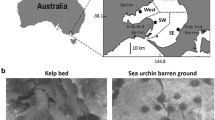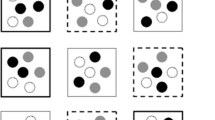Abstract
Macrobenthic community structure and the distribution of the green sea urchin (Strongylocentrotus droebachiensis) were recorded inside and outside (=barrens) of kelp patches (Alaria esculenta) at Kongsfjordneset, Svalbard between August 2002 and October 2006. In manipulative field experiments, conducted at Kongsfjordneset, Svalbard in August 2002, the effect of the presence of the brown seaweed Desmarestia viridis on sea urchin distribution and kelp grazing was determined. Additionally, we studied the effect of sulphuric acid, which is produced and stored by D. viridis, on sea urchin movements in the laboratory at Ny-Ålesund, Svalbard, in May 2006. Sea urchin densities were two- to threefold lower in kelp patches than on barrens. The macrobenthic community inside kelp patches hosted 39% more species and was of different species composition than on barrens. Anchored pieces of the kelp A. esculenta were less consumed when surrounded by D. viridis than non-surrounded conspecifics. Changes in pH affected the behaviour of sea urchins. Exposing sea urchins to 500 μl seawater at pH 7.5 caused them to stop, while the exposure of as little as 25 μl at pH 1 caused sea urchins to move in the opposite direction. Acid-mediated escape responses in sea urchin behaviour suggest chemical protection by D. viridis as an additional mechanism to mechanical protection in the generation of kelp refuges. These results improve our understanding of how isolated kelp beds can persist over a wide range of environmental conditions, like wave-sheltered sites, and suggest that changes in community structure may be in part attributable to altered trophic interactions.






Similar content being viewed by others
References
Amsler CD, Fairhead VA (2006) Defensive and sensory chemical ecology of brown algae. Adv Bot Res 43:1–91
Atsatt PR, O’Dowd DJ (1976) Plant defense guilds. Science 193:24–29
Augustine DJ, McNaughton SJ (2004) Regulation of shrub dynamics by native browsing ungulates on East African rangeland. J Appl Ecol 41:45–58
Begin C, Johnson LE, Himmelman JH (2004) Macroalgal canopies: distribution and diversity of associated invertebrates and effects on the recruitment and growth of mussels. Mar Ecol Prog Ser 271:121–132
Bernstein BB, Mann KH (1982) Changes in the nearshore ecosystem of the Atlantic coast of Nova Scotia, 1968–81. Sci Counc Stud 5:101–105
Bernstein BB, Williams BE, Mann KH (1981) The role of behavioral responses to predators in modifying urchins’ (Strongylocentrotus droebachiensis) destructive grazing and seasonal foraging patterns. Mar Biol 63:39–49
Bers AV, D’Souza F, Klijnstra JW, Willemsen PR, Wahl M (2006) Chemical defence in mussels: antifouling effect of crude extracts of the periostracum of the blue mussel Mytilus edulis. Biofouling 22:251–259
Beuchel F, Gulliksen B (2008) Temporal patterns of benthic community development in an Arctic fjord (Kongsfjorden, Svalbard): results of a 24-year manipulation study. Polar Biol 31:913–924
Connell JH, Slatyer RO (1977) Mechanisms of succession in natural communities and their role in community stability and organisation. Am Nat 111:1119–1144
Cyr H, Pace ML (1993) Magnitude and patterns of herbivory in aquatic and terrestrial ecosystems. Nature 361:148–150
Dean RL, Connell JH (1987) Marine invertebrates in an alga succession. III. Mechanisms linking habitat complexity with diversity. J Exp Biol Ecol 109:249–273
Duffy JE, Hay ME (2000) Strong impacts of grazing amphipods on the organization of a benthic community. Ecol Monogr 70:237–263
Durr S, Wahl M (2004) Isolated and combined impacts of blue mussels (Mytilus edulis) and barnacles (Balanus improvisus) on structure and diversity of a fouling community. J Exp Biol Ecol 306:181–195
Eckman JE (1983) Hydrodynamic processes affecting benthic recruitment. Limnol Oceanogr 28:241–257
Estes JA, Tinker MT, Williams TM, Doak DF (1998) Killer whale predation on sea otters linking oceanic and nearshore ecosystems. Science 282:473–476
Gagnon P, Himmelman JH, Johnson LE (2003) Algal colonization in urchin barrens: defense by association during recruitment of the brown alga Agarum cribrosum. J Exp Biol Ecol 290:179–196
Gagnon P, Himmelman JH, Johnson LE (2004) Temporal variation in community interfaces: kelp-bed boundary dynamics adjacent to persistent urchin barrens. Mar Biol 144:1191–1203
Gagnon P, Johnson LE, Himmelman JH (2005) Kelp patch dynamics in the face of intense herbivory: stability of Agarum clathratum (Phaeophyta) stands and associated flora on urchin barrens. J Phycol 41:498–505
Gagnon P, St-Hilaire-Gravel LV, Himmelman JH, Johnson LE (2006) Organismal defenses versus environmentally mediated protection from herbivores: Unravelling the puzzling case of Desmarestia viridis (Phaeophyta). J Exp Biol Ecol 334:10–19
Gordon R, Brawley SH (2004) Effects of water motion on propagule release from algae with complex life histories. Mar Biol 145:21–29
Hagen NT (1996) Parasitic castration of the green echinoid Strongylocentrotus droebachiensis by the nematode endoparasite Echinomermella matsi: reduced reproductive potential and reproductive death. Dis Aquati Org 24:215–226
Hanelt D, Tug H, Bischof K, Gross C, Lippert H, Sawall T, Wiencke C (2001) Light regime in an arctic fiord: a study related to stratospheric ozone depletion as a basis for determination of UV effects on algal growth. Mar Biol 138:649–658
Hay ME (1991a) Fish-seaweed interactions on coral reefs: effects of herbivorous fishes and adaptations of their prey. In: Sale PF (ed) The ecology of fishes on coral reefs. Academic Press, San Diego, pp 96–118
Hay ME (1991b) Marine-terrestrial contrasts in the ecology of plant chemical defenses against herbivores. Trends Ecol Evol 6:362–365
Hay ME (1992) The role of seaweed chemical defenses in the evolution of feeding specialization and in the mediation of complex interactions. In: Paul VJ (ed) Ecological roles of marine natural products. Comstock, Ithaca, pp 93–118
Hay ME, Fenical W, Gustafson K (1987) Chemical defense against diverse coral-reef herbivores. Ecology 68:1581–1591
Hay ME, Paul VJ, Lewis SM, Gustafson K, Tucker J, Trindell RN (1988) Can tropical seaweeds reduce herbivory by growing at night? Diet patterns of growth, nitrogen content, herbivory, and chemical versus morphological defenses. Oecologia 75:233–245
Himmelman JH, Nedelec H (1990) Urchin foraging and algal survival strategies in intensely grazed communities in Eastern Canada. Can J Fish Aquat Sci 47:1011–1026
Hooper DU, Chapin FS, Ewel JJ, Hector A, Inchausti P, Lavorel S, Lawton JH, Lodge DM, Loreau M, Naeem S, Schmid B, Setala H, Symstad AJ, Vandermeer J, Wardle DA (2005) Effects of biodiversity on ecosystem functioning: a consensus of current knowledge. Ecol Monogr 75:3–35
Hop H, Pearson T, Hegseth EN, Kovacs KM, Wiencke C, Kwasniewski S, Eiane K, Mehlum F, Gulliksen B, Wlodarska-Kowalezuk M, Lydersen C, Weslawski JM, Cochrane S, Gabrielsen GW, Leakey RJG, Lønne OJ, Zajaczkowski M, Falk-Petersen S, Kendall M, Wängberg S-Å, Bischof K, Voronkov AY, Kovaltchouk NA, Wiktor J, Poltermann M, di Prisco G, Papucci C, Gerland S (2002) The marine ecosystem of Kongsfjorden, Svalbard. Polar Res 21:167–208
Kain JM (1963) Aspects of the biology of Laminaria hyperborea II. Age, weight and length. J Mar Biol Assoc UK 43:129–151
Kawamata S (1998) Effect of wave-induced oscillatory flow on grazing by a subtidal sea urchin Strongylocentrotus nudus (A. Agassiz). J Exp Biol Ecol 224:31–48
Kennelly SJ (1989) Effects of kelp canopies on understorey species due to shade and scour. Mar Ecol Prog Ser 50:215–224
Konar B (2000) Seasonal inhibitory effects of marine plants on sea urchins: structuring communities the algal way. Oecologia 125:208–217
Konar B, Estes JA (2003) The stability of boundary regions between kelp beds and deforested areas. Ecology 84:174–185
Kusumo HT, Druehl LD (2000) Variability over space and time in the genetic structure of the winged kelp Alaria marginata. Mar Biol 136:397–409
Lauzon-Guay JS, Scheibling RE (2006) Behaviour of sea urchin Strongylocentrotus droebachiensis grazing fronts: food-mediated aggregation and density-dependent facilitation. Mar Ecol Prog Ser 329:191–204
Lauzon-Guay JS, Scheibling RE (2007) Seasonal variation in movement, aggregation and destructive grazing of the green sea urchin (Strongylocentrotus droebachiensis) in relation to wave action and sea temperature. Mar Biol 151:2109–2118
McClintock M, Higinbotham N, Uribe EG, Cleland RE (1982) Active, irreversible accumulation of extreme levels of H2SO4 in the brown alga, Desmarestia. Plant Physiol 70:771–774
Milchunas DG, Noy-Meir I (2002) Grazing refuges, external avoidance of herbivory and plant diversity. Oikos 99:113–130
Miller RJ (1985) Succession in sea-urchin and seaweed abundance in Nova-Scotia, Canada. Mar Biol 84:275–286
Naeem S, Wright JP (2003) Disentangling biodiversity effects on ecosystem functioning: deriving solutions to a seemingly insurmountable problem. Ecol Lett 6:567–579
Norderhaug KM, Christie H, Rinde E (2002) Colonisation of kelp imitations by epiphyte and holdfast fauna; a study of mobility patterns. Mar Biol 141:965–973
Norderhaug KM, Christie H, Fosså JH, Fredriksen S (2005) Fish-macrofauna interactions in a kelp (Laminaria hyperborea) forest. J Mar Biol Assoc UK 85:1279–1286
Pelletreau KN, Muller-Parker G (2002) Sulfuric acid in the phaeophyte alga Desmarestia munda deters feeding by the sea urchin Strongylocentrotus droebachiensis. Mar Biol 141:1–9
Pfister CA, Hay ME (1988) Associational plant refuges: convergent patterns in marine and terrestrial communities result from differing mechanisms. Oecologia 77:118–129
Sahade R, Stellfeldt A, Tatian M, Laudien J (2004) Macro-epibenthic communities and diversity of arctic Kongsfjorden, Svalbard, in relation to depth and substrate. Rep Polar Mar Res 492:103–113
Scheibling RE, Hennigar AW, Balch T (1999) Destructive grazing, epiphytism, and disease: the dynamics of sea urchin—kelp interactions in Nova Scotia. Can J Fish Aquat Sci 56:2300–2314
Sjøtun K, Christie H, Fosså JH (2006) The combined effect of canopy shading and sea urchin grazing on recruitment in kelp forest (Laminaria hyperborea). Mar Biol Res 2:24–32
Stolpe U, Wiencke C, Clayton MN, Lehmann H (1991) Life history, morphology and development of a ligulate Desmarestia species from southernmost Chile. Eur J Phycol 26:235–245
Svendsen H, Beszczynska-Møller A, Hagen JO, Lefauconnier B, Tverberg V, Gerland S, Ørbæk JB, Bischof K, Papucci C, Zajaczkowski M, Azzolini R, Bruland O, Wiencke C, Winther J-G, Dallmann W (2002) The physical environment of Kongsfjorden–Krossfjorden: an Arctic fjord system in Svalbard. Polar Res 21:167–208
Underwood AJ (1997) Experiments in ecology. University Press, Cambridge
Velimirov B, Griffiths CL (1979) Wave-induced kelp movements and its importance for community structure. Bot Mar 22:169–172
Wahl M, Kröger K, Lenz M (1998) Non-toxic protection against epibiosis. Biofouling 12:205–226
Wessels H, Hagen W, Molis M, Wiencke C, Karsten U (2006) Intra- and interspecific differences in palatability of Arctic macroalgae from Kongsfjorden (Spitsbergen) for two benthic sympatric invertebrates. J Exp Mar Biol Ecol 329:20–33
Wiencke C, Vögele B, Kovaltchouk NA, Hop H (2004) Species composition and zonation of marine benthic macroalgae at Hansneset in Kongsfjorden, Svalbard. In: Wiencke C (ed) The coastal ecosystem of Kongsfjorden, Svalbard. Synopsis of biological research performed at the Koldewey-Station in the years 1991–2003. Reports on Polar and Marine Research 492. Alfred-Wegener-Institute for Polar and Marine Research, Bremerhaven, pp 55–62
Worm B, Duffy JE (2003) Biodiversity, productivity and stability in real food webs. Trends Ecol Evol 18:628–632
Zajaczkowski MJ, Legezynska J (2001) Estimation of zooplankton mortality caused by an Arctic glacier outflow. Oceanologia 43:341–351
Acknowledgments
Financial support by the Deutsche Forschungsgemeinschaft (DFG) to W.H. (HA 1706/6-1/2) and U.K. (KA 899/6-1/2) is gratefully acknowledged. We thank Claudia Daniel, and Peter Leopold and especially the head of the diving group, Max Schwanitz, for excellent dive support. Thanks go also to Lise Chapman for discussions on and practical assistance in 2006 laboratory assays. This work was performed at the Ny-Ǻlesund International Research and Monitoring Facility in Svalbard. We thank H. Hop and two anonymous reviewers for their constructive comments on an earlier version of the manuscript.
Author information
Authors and Affiliations
Corresponding author
Rights and permissions
About this article
Cite this article
Molis, M., Wessels, H., Hagen, W. et al. Do sulphuric acid and the brown alga Desmarestia viridis support community structure in Arctic kelp patches by altering grazing impact, distribution patterns, and behaviour of sea urchins?. Polar Biol 32, 71–82 (2009). https://doi.org/10.1007/s00300-008-0504-2
Received:
Revised:
Accepted:
Published:
Issue Date:
DOI: https://doi.org/10.1007/s00300-008-0504-2




